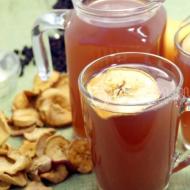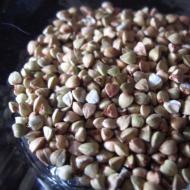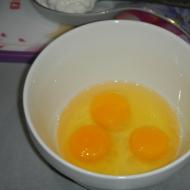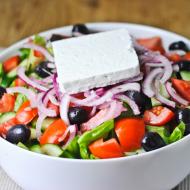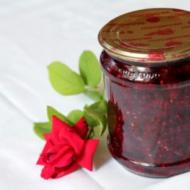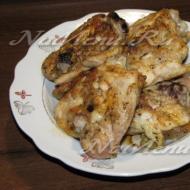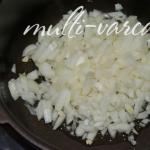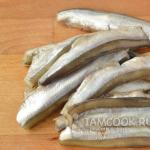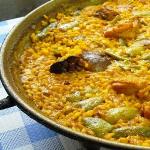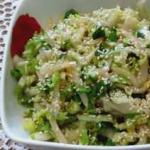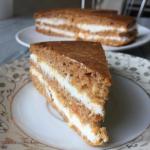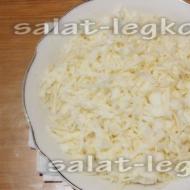
How many calories are in 100 grams of buckwheat porridge. Calorie content of buckwheat boiled in water and dishes based on it
“Buckwheat porridge is our mother, and rye bread is our dear father,” says a Russian proverb. After all, buckwheat has been known in Rus' since ancient times. Where did she come to us from?
A short excursion into history
Archaeologists find traces of buckwheat in the most ancient layers. It has been known almost from the very beginning of human cultivation of wild plants. Most historians are inclined to believe that the inhabitants of the Himalayan mountains were the first to grow it. Evidence has also been found of this grain being eaten in northern India and Nepal six thousand years ago. In Europe, buckwheat became widely used during the Crusades.
Judging by the sound in Russian, some historians suggest that buckwheat came to us from Greece. It was brought to us by traders across the Black Sea. And residents on the northern borders of our country call her “Tatar”. This suggests that it came to us during the invasion of the Golden Horde.
And by the way, buckwheat is found in the wild almost throughout the entire territory of our globe.
Buckwheat and diabetes
For people suffering from this serious chronic disease, the best and irreplaceable cereal is buckwheat. The calorie content per 100 grams of boiled cereal with butter will be 120-130 kcal. The porridge contains so-called They are absorbed gradually and therefore do not cause a sharp decrease in insulin levels. To improve the taste, just add 2-3 grams of butter or vegetable oil per 100 grams of prepared buckwheat. Appetizing and ready. And the low calorie content is very important for diabetics.
A little about buckwheat microelements

“The Queen of Porridges” - that’s what many nutrition experts call her. And that's why.
- Micro- and macroelements. It contains copper several times more than the daily requirement. Iron is also present in this cereal. And in union, these two elements are simply irreplaceable for the human body. They take part in the synthesis of hemoglobin, bone tissue, the sheath of nerve fibers and the walls of blood vessels.
- Unique combination of boron, phosphorus and calcium makes this cereal an excellent assistant in the prevention of diseases such as arthritis, arthrosis, osteoporosis. And buckwheat can prevent the formation of kidney stones. The calorie content per 100 grams, with all the variety of useful components, will be equal to only 150 kcal. And this involves adding butter and sugar to your favorite porridge.
In addition, buckwheat contains the following elements: selenium, silicon, chlorine, sulfur, magnesium, potassium, molybdenum, zinc and iodine. Our body needs all of them for normal functioning.
Buckwheat: calorie content per 100 grams
In the modern world, most people try to monitor their weight. Therefore, the question arises about the energy value of cereals such as buckwheat.
The calorie content per 100 grams of dry cereal is about 327 kcal. At first glance, this is a crazy amount. But during heat treatment, the volume of cereal increases 3-3.5 times. And from 100 grams of dry buckwheat you get 300-350 grams of delicious porridge. To satiate the average person, it is enough to eat 100-150 grams of ready-made food. The result is only 110-170 kcal.
Vitamin composition
There is not as much of this goodness in buckwheat as there are microelements. But there are still representatives of groups A, E, B, RR. All of them are useful for the cardiovascular and nervous systems, the digestive tract.
In addition, cereal helps lower cholesterol, reduces blood pressure and prevents the formation of blood clots and cholesterol plaques.
This is what a good and healthy cereal is - buckwheat! The calorie content per 100 grams of cereal boiled in milk is only 120-130 kcal. And the benefits from it for the whole body are enormous.
The sextons also know that they cook porridge from buckwheat

Another folk wisdom. And here is the recipe for cooking with water.
1. Pour 200 grams of clean, washed cereal into a pan.
2. Pour 400 ml of water there.
3. Bring to a boil and cook for a quarter of an hour over low heat.
4. The porridge must be stirred periodically and be sure to cover with a lid.
5. Remove from heat, wrap and place in a warm place for 20-30 minutes.
So, our buckwheat is ready. 100 grams (boiled porridge has only 100-110 kcal in calories) is the optimal serving size for an adult who is watching his weight.
Let's prepare the porridge without cooking. For this you need boiling water and a thermos. Add 1 cup of cereal and pour 2 cups of hot water. Close tightly and wait half an hour. So our buckwheat is ready. The calorie content per 100 grams will be 110-120 kcal in this version. But all microelements and vitamins will be preserved.
For those who strive for a wasp waist

Buckwheat in any culinary form is completely digestible. But everything absorbed by our body is used 100%. Not a gram of eaten porridge will remain in problem areas of our body.
And here is another excellent recipe for wonderful cereals.
Buckwheat
This dish was very popular in Soviet Russia. It was often prepared in children's institutions and catering establishments. Everything is done very simply.
1. It is necessary to cook the porridge - “mud”. To do this, take cereal and water in a ratio of 1:3. Cook over low heat.
3. Prepare the baking sheet. Grease with any oil or cover with parchment paper.
4. Spread the porridge and let it harden.
5. Cut the cooled “smear” into pieces and fry on both sides.
These very tasty and nutritious buckwheats can be a wonderful addition to any dish. The main component of this wonderful dish is buckwheat. The calorie content per 100 grams is only 150 kcal.
Buckwheat has always been considered a strong and courageous food. And this is natural, because everyone will be surprised by how many calories are in buckwheat. Thanks to this, a person gained health and strength. In addition, it has long been proven that these grains help relieve people of weight, if they are used correctly. Just imagine, you need to add just a few spoons of this miracle cereal to your daily diet, and your body will no longer contain harmful substances, heavy metals, and the hated cholesterol. All this accumulates in the body over the years, and she will helpfully rid you of these nasty things. It is important not to overdo it with its use.
It contains carbohydrates, vegetable protein and a lot of micro and macroelements. In a word, this cereal contains almost all the substances that are extremely necessary for the body.
In particular:
- Iron, which serves to strengthen the skin.
- Manganese, which strengthens bone tissue and helps slow down aging.
- Selenium, known as an inflammation fighter and protector against viruses and bacteria.
- Copper, which heals wounds and promotes good digestion.
- Phosphorus, producing glucose, involved in metabolism
- Potassium, which removes harmful substances, in particular toxins, from the body.
- Magnesium, which improves the functioning of the nervous system and cardiovascular system.
- Iodine, which coordinates the precise functioning of the thyroid gland.
Therefore, if we talk about how nutritious buckwheat is, then we need to take into account how much fat, protein, carbohydrates it contains, as well as mineral and organic substances, acids and vitamins. There are a lot of carbohydrates in cereals, there are 18 grams per 100 grams. As for proteins and fats, they are 3.6 and 2.2, respectively. It is a mistake to think that if a cereal is nutritious, it means it contains a lot of calories. The main secret of nutrition is that carbohydrates are very quickly and easily absorbed in the body. And this is even despite the fact that carbohydrates usually break down slowly when they enter the body.
How many calories are in buckwheat?
The low calorie content of buckwheat per 100 grams allows it to be included even in the diet menu. Doctors often recommend adding this product to your diet, in particular to those patients who suffer from swelling. And the reason is that buckwheat, which is prepared without the use of salt, can remove unnecessary fluid from the body. If you regularly eat boiled cereals, you can improve the functioning of your stomach and intestines. Even for those who are overweight, doctors prescribe this cereal.
Important! At the same time, it is important to understand that it is steamed without adding salt that will help you get rid of the hated kilograms.
There are many ways to prepare buckwheat. The energy value of the finished product differs in each of them, so it is worth talking about each of them.
Boiled buckwheat in water
Not many people know how many calories are in boiled buckwheat. Boiled cereal is useful, but it is important not to add salt. In this case, 100 grams of the finished product will contain 90 calories. But if you decide to add salt to the dish, the indicator will increase to 103.
To make buckwheat even tastier, some add butter, but this is also fraught with extra calories, which in this case will increase to 152. Thanks to this cereal, you can prepare a tasty and healthy side dish that will appeal to absolutely all family members. There are such delicious recipes as buckwheat cutlets, and monastery-style porridge, the peculiarity of its preparation lies in the addition of vegetables and mushrooms.
Buckwheat steamed with water
As previously reported, buckwheat is useful for those losing weight, namely steamed cereals. Doctors recommend consuming it this way, because the calorie content of buckwheat in this case is low.
Practical advice: All you need to do is boil water and add boiling water to the cereal in a ratio of one to two. Then it is left overnight. You get 105 calories per serving per 100 grams.
At the same time, the cereal will be distinguished by its nutritional value and softness. Those losing weight eat it in unlimited quantities, and at different times of the day. And the advantage of this method of losing weight is that after eating you will not feel hungry.
Dry product
Interestingly, dry buckwheat contains much more calories than cooked buckwheat. So, there are 330 of them per 100 grams. But even this is not critical and is only 15% of the daily requirement. And if you consider that after cooking the cereal becomes three times larger, then from one hundred grams of dry cereal you can ultimately get three hundred grams of a tasty and complete breakfast, lunch or dinner. And fat deposits will not be scary for you either. Adherents of a healthy and proper diet often eat live green buckwheat. To do this, the fruit is separated from the buckwheat grain and eaten. In this form, the calorie content is 310 calories.
Calorie content of dishes made from buckwheat
Of course, when talking about the calorie content of a particular dish that contains buckwheat, you need to take into account the nutritional value of each component of this dish. You also need to pay attention to the technology and method of preparation: boiling or frying.
But there are the most common and popular buckwheat dishes, the calorie content of which has already been calculated:
- Like a merchant. To prepare it you need chicken fillet, onions, carrots and core. It is important to note that to prepare the dish you need vegetable oil, as well as spices. As a result, 200 grams of the finished dish will contain 470 calories.
- Dish made with kefir. An excellent option for weight loss is buckwheat cooked with kefir or yogurt. You need to take a dairy product with zero fat content. 200 grams of milk should be mixed with two teaspoons of cereal. Leave it like that overnight. Eating this dish in the morning is beneficial not only for adults, but also for children. For 100 grams you get only 51 calories.
- With milk. The taste of childhood is buckwheat with milk. You need 100 grams of cereal and the same amount of milk. Add a little sugar and 200 grams of water. One hundred grams of the dish contains only 100 calories.
- Cereals with butter. To prepare the dish you need 150 grams of cereal, 200 grams of water, 15 grams of butter, 10 grams of sugar. A serving will yield 330 grams, and 100 - 120 calories.
- Buckwheat with meat. This is a denser dish. You will need chicken breast, as well as dressing in the form of vegetables, sour cream and onions. Here you need to include spices and vegetable or olive oil. Per 100 grams – 180 calories.
- Cereals with mushrooms. You will need fresh honey mushrooms (in their raw form they have 17 calories). Add here herbs, cereals, vegetables, spices and vegetable oil, and the result is a calorie content of 105 per 100 grams.
- Buckwheat with stew. This dish can hardly be included in the list of healthy dishes, but many people prefer it. Combine 120 grams of buckwheat in water with 250 grams of stew made from beef. As a result, we get 130 kcal per 100 grams.
How is buckwheat useful?
Nutritionists, doctors and other specialists have long condemned the beneficial properties of buckwheat. There are also contraindications to its use, but there are many more beneficial properties. So, if you consume a lot of this cereal, gas formation and stimulation of peristalsis may occur. But you can’t completely exclude buckwheat from your menu, because it has a beneficial effect on the body:
- Normalizes blood pressure
- Restores the strength of hair, nails and fights caries
- Helps improve mood
- Gets rid of extra pounds.
- Fights rheumatism, reducing joint pain
- Fights atherosclerosis, heartburn and skin diseases.
A product familiar to everyone from childhood is boiled buckwheat. Grandmothers and mothers prepared it in the same way, but each time they added something new, and we didn’t get tired of the dish at all. In adulthood, when it comes to adjusting their figure, many women are interested in the question of the calorie content of each dietary product. Morning milk porridge with sugar, buckwheat with butter and salad, with mushroom gravy, inside cutlets - what is the calorie content of boiled buckwheat for different cooking options? Let's figure it out.
Composition and beneficial properties of boiled buckwheat
If you adhere to a healthy diet, then your diet will not be complete without buckwheat, because its composition is very beneficial for the body. Porridge from this cereal has many vitamins, such as B5, B6, A, PP, E, folic acid. It contains micro- and macroelements: potassium, magnesium, sodium, phosphorus, calcium, iron, manganese, copper, zinc, selenium. Slow carbohydrates, which are found in buckwheat, help quickly saturate the body for a long time.
Due to its beneficial properties, many doctors recommend consuming this cereal for significant excess weight, varicose veins, diabetes, arthritis, hemorrhoids, atherosclerosis, diseases of the gastrointestinal tract and cardiovascular system. Nutritionists include it in the diet of those who want to lose weight faster, although buckwheat is high in calories. The fatty acids that make up the porridge are considered polyunsaturated, therefore they lower cholesterol levels and speed up metabolism in the body.
The low glycemic index allows people with diabetes to replace baked goods and potatoes with buckwheat. Most of the fiber in porridge prevents all carbohydrates from being absorbed, so blood sugar does not rise. Folic acid is necessary for women in the first trimester of pregnancy, because this element prevents the development of pathologies in the fetus. It is also useful in stimulating hematopoiesis and increases the body’s resistance to radiation and other harmful external environmental factors.
Buckwheat contains a lot of protein (13%), which contains 18 amino acids. Porridge is compared to chicken eggs and milk powder in terms of the presence of essential elements. Traditional medicine advises drinking a decoction of buckwheat during viral colds. For dry coughs, it is used for expectoration. Ointments with buckwheat flour are used to treat skin diseases and malignant tumors.
How many calories are in raw buckwheat?
If you follow a strict diet, then calculating the number of calories you eat per day is a common thing for you. In order to feel full while following a diet and not suffer from hunger, you need to eat buckwheat; you will fill up with it faster than the same portion of pasta or potatoes. The calorie content of dry porridge is 330 kcal per 100 grams of product.
Calorie content of boiled buckwheat in water without oil
During the cooking process, buckwheat grains swell almost three times. If you put 100 g of dry porridge in water to boil, then the calorie content will be equivalent to 300 g of ready-made porridge. Sometimes the calorie number changes due to temperature, so the final number becomes slightly smaller. As a result, the calorie content of boiled buckwheat is 92-110 kcal per 100 grams of the finished product. This number varies depending on the type of cereal.
During the cooking process, beneficial substances remain in the porridge. Vitamins B, A, PP, E, folic acid do not evaporate. Micro- and macroelements have a beneficial effect on the body when cereal is consumed daily. According to nutritionists, if you want to lose weight, buckwheat porridge should be prepared without salt and oil. Many people recommend not even boiling it, but pouring boiling water over it overnight. Children's doctors advise starting complementary feeding for infants with buckwheat porridge without milk.
With milk
The calorie content of buckwheat cooked with milk is higher than that of cereal cooked with water. The figure depends on the milk you choose, or more precisely, the percentage of fat content. Choose a low-fat option to reduce your calorie intake. If you follow a mono-diet or any other diet, refuse to use homemade whole milk.
Calorie content of 100 g of buckwheat boiled in milk is 340-360 kcal. Proteins in the composition are 12-16 grams, fats are 3 g, the remaining components are slow carbohydrates. In case of allergic reactions, young children are advised to drink goat's milk; it is not so hard on the stomach. If this is not possible, try diluting the whole natural product with water in a 2:1 ratio. By adding dried fruits and nuts to your buckwheat diet, you will be full almost the whole day.
Buckwheat is a ubiquitous product that is included in the diet of people of all ages. This culture has many beneficial substances that have a beneficial effect on the body.
Eating this product brings the following benefits:
- ensures the functioning of the nervous system;
- brain activity increases;
- the functioning of the digestive system is stabilized;
- the risk of developing cancer cells is reduced;
- blood vessels are strengthened;
- the immune system is stimulated.
Due to the average calorie content of buckwheat boiled in water with salt, this product is a component of many diets.
Buckwheat-based nutrition allows you to achieve the following effect:
- cholesterol levels decrease;
- the liver is cleansed of toxins;
- the condition of blood vessels improves;
- the likelihood of developing atherosclerosis is reduced;
- hematopoiesis and heart muscle function improves;
- pressure decreases;
- the activity of the nervous system improves, the depressive mood goes away;
- Inflammatory processes and swelling disappear.
During physical activity, buckwheat helps gain muscle mass. If you consume buckwheat a few hours before training, then during this time enough energy is generated to cope with the load.

Due to its ability to remove toxins, buckwheat helps improve skin condition. As a result, acne goes away and the skin becomes more elastic.
Calorie content of buckwheat
100 g of buckwheat contains 313 calories. This is a fairly low calorie content, so buckwheat is suitable for the diet menu.
Note! Buckwheat contains 12.7 g of protein, 3.3 g of fat and 62.1 g of carbohydrates.
Buckwheat is obtained from buckwheat grains by separating the shell and kernel. Depending on the quality of the kernel, buckwheat is of first, second or third grade.

With a low calorie content, the supply of minerals in buckwheat is quite high. Their content is approximately twice as high as that of other types of cereals.
The calorie content of buckwheat is not the lowest, but many diets are recommended based on it. Its ability to improve metabolic processes allows you to burn more calories.
Note! The amount of carbohydrates in buckwheat is minimal, and all of them are easily absorbed by the body.
Most of the fats contained in buckwheat are polyunsaturated due to their organic origin. Therefore, they have a beneficial effect on fat metabolism. Another effect they have is to lower cholesterol.
Calorie content of buckwheat boiled in water with salt
Boiled buckwheat is one of the simplest ways to prepare this product. This method of cooking affects the content of nutrients in the final dish.

During the cooking process, buckwheat grains swell and absorb liquid. As a result, their size increases three times.
As a result, the energy value of 100 g of buckwheat is as follows:
Buckwheat porridge does not contain saturated fats and carbohydrates, which are quickly absorbed by the body.
Note! If you do not add salt, then the calorie content of buckwheat boiled in water will be up to 105 kcal.
To preserve the beneficial substances found in buckwheat, you can pour cold water over the cereal for several hours. Then the cold water is drained and the container with the cereal is filled with boiled water, and covered with a warm blanket. In the morning, the porridge is ready to eat.
Calorie content of buckwheat with milk
When milk is added, the calorie content of buckwheat porridge increases. Here a lot depends on the fat content of the dairy product.

When using a dairy product with 1.5% fat content, the calorie content of the porridge will be about 150 kcal. If the fat content of milk is 2.5%, then the calorie content of the dish will increase to 160 kcal. With a fat content of 3.2%, the energy value will be 170 kcal.
For your diet, it is better to choose low-fat milk. The calorie content of porridge also increases with the addition of sugar, honey, and dried fruits.
How to lose weight on buckwheat - recipes
A classic way to lose weight is to eat buckwheat porridge. You should drink buckwheat with clean water or herbal tea. The meal will be repeated at least three times a day. The duration of the diet should not exceed 7 days.
Although the calorie content of buckwheat boiled in water with salt is considered quite low, other products can be added to dishes:
- Buckwheat porridge can be combined with kefir. In this case, the duration of the diet can be extended to two weeks. Kefir is known for its dietary properties that promote the digestive system.

- With the addition of dried fruits. Buckwheat porridge is combined with prunes, dried apricots, dates, and figs. Their content should not exceed 100 g per day. The duration of treatment can be extended to 14 days.
- With honey. After buckwheat porridge, drink two glasses of clean water with a teaspoon of honey. The diet course lasts up to 7 days.
- Therapeutic diet. You can add low-fat cottage cheese and stewed vegetables to the menu.
- A gentle diet. In addition to buckwheat porridge, the diet includes vegetable salad and fruits.

- Balanced mode. Fish, meat and vegetables are added to buckwheat. The daily norm of additional products is up to 300 g. The duration of such a diet increases to 3 weeks.
Contraindications for buckwheat diet
The buckwheat diet has a number of contraindications. This includes health problems and temporary illnesses.
The buckwheat diet is contraindicated for the following diseases:
- diabetes;
- stomach problems (ulcers, gastritis);
- intestinal disorders;
- low metabolism;
- disorders of the heart and blood vessels;
- high blood clotting.

The average calorie content of buckwheat boiled in water with salt does not allow you to go on a diet in the following physiological conditions:
- childhood and adolescence;
- expecting a child;
- breastfeeding period;
- discomfort during menstruation;
- manifestations of menopause.
Important! In the process of taking buckwheat, fatigue often increases, drowsiness or headache occurs.
You should abandon the diet in cases where maximum concentration and brain function are required.
This includes preparation for exams, competitions, and stressful periods at work. At this time, a complete supply of nutrients is required to ensure the functioning of the brain and the whole body.
Buckwheat is a dietary product with a rich supply of nutrients. Due to its average calorie content, this crop helps speed up metabolism and lose excess weight.
The buckwheat diet allows the addition of other low-fat foods(kefir, honey, cottage cheese, dried fruits). When following a dietary regimen, you need to monitor the condition of the body.
Buckwheat diet (features, menu, way out)

Every modern woman dreams of looking beautiful and attractive, slim and well-groomed, and does everything possible for this.
A variety of creams and masks, scrubs and gels, massages and sauna, fitness and gym, diets and teas for weight loss. Truly, What modern women will do to look their best.
Nowadays, there are many different diets, which differ only in timing, diet and effectiveness. Now we will talk about the buckwheat diet for weight loss.
She has enjoyed well-deserved success among women for many years, and she is still popular today.
Diet features
The main feature of the diet, as can be understood from the name itself, is that buckwheat porridge becomes the main food for the diet period. Buckwheat is not only very tasty and filling, but also very healthy.
 The calorie content of buckwheat boiled in water with salt is approximately 105 kcal, and the presence of salt does not increase the total calorie content of the product
The calorie content of buckwheat boiled in water with salt is approximately 105 kcal, and the presence of salt does not increase the total calorie content of the product It is an excellent preventive measure for cardiovascular diseases, as it removes cholesterol from the body.
Buckwheat porridge is rich in vitamins and minerals, beneficial metals and microelements. Another feature of the buckwheat diet is its high effectiveness: nutritionists and those losing weight claim that in 7 days of the buckwheat diet it is quite possible to lose 5 kilograms or more.
However, the buckwheat diet is considered quite strict. People who don’t really like buckwheat most likely won’t be able to stand eating only it for more than 7 days. Buckwheat is great for preventing the gastrointestinal tract and perfectly cleanses the body.

During this diet, it is recommended to drink plenty of fluids, including low-fat kefir or yoghurts, green, black and herbal teas, still mineral water and simple purified boiled water. In 2 weeks it is quite possible to get rid of 10-15 extra pounds.
Diet
The menu is very simple. The main product in your diet should be buckwheat, which must be prepared in a certain way, namely: steam the porridge for 8 hours or more. The ratio is as follows: for a glass of buckwheat, take two glasses of boiling water.
Steam the porridge for at least 8 hours (preferably overnight). In the morning, if there is water left in the porridge, simply drain it and our buckwheat porridge is ready. Please note that you cannot add salt, pepper, sugar or any other seasonings to the porridge.

The only sauce allowed is a little soy sauce. You can eat buckwheat porridge throughout the day as much as you want; there are no restrictions on the amount of food.
You should also drink at least two liters of water per day. A variety of teas are allowed (hibiscus, green, black, red, herbal) but only without sugar.
If you are very tired of buckwheat, you can drink a little low-fat kefir or low-fat yogurt. You are allowed to eat a teaspoon of natural honey per day. It is not advisable to drink coffee, but if it is very difficult for you to give up this habit, you can drink 1 cup per day (but without cream and sugar).

Also It is allowed to eat vegetable salads without any dressings(white cabbage, tomatoes, bell peppers, cucumbers). The only fruits you can eat are watermelon and sour apples, but this is only in extreme cases. That's all, as we see, the menu of this diet is not complicated and not expensive.
Pros and cons of buckwheat porridge
The advantages of the diet include the following:
- Buckwheat is very rich in vitamins and beneficial microelements, which is beneficial for the general condition of our body.
- Buckwheat porridge removes cholesterol from the body, which clogs it; this is also a huge advantage of the buckwheat diet.
- Buckwheat contains zinc and magnesium and perfectly cleanses skin pores, which promotes a beautiful and healthy complexion.
One of the disadvantages is monotony. Agree, eating only buckwheat porridge for two weeks in a row is very boring, but this is why it is highly effective.
There are practically no diets that can compare in effectiveness with buckwheat: in two weeks of dietary nutrition, you lose from 10 to 15 kilograms.
One of the disadvantages is the lack of salt and spices, which makes the taste of food poor. But at the same time, salt promotes fluid retention in the body, which leads to swelling.

Another positive thing is that you can afford some fresh vegetables and freshly squeezed juices. You are also allowed to consume low-fat yoghurts and kefir.
As you can see, the buckwheat diet, in principle, has no categorical disadvantages, nor any advantages. Each characteristic of this diet is two-sided: it is both positive and negative. The buckwheat diet is not recommended for people who suffer from chronic gastrointestinal diseases and vitamin deficiencies.
The right way out of the diet
The correct exit from any diet is always gradual if your goal is not only to lose weight, but also to maintain the lost weight. Nutritionists recommend that at the end of the buckwheat diet you gradually diversify your daily diet with salt, sugar and spices.
You can also add some dressings: olive and corn oil, apple and grape cider vinegar, soy sauce. Little by little you need to introduce other cereals: rice, corn and oatmeal. You can start drinking yoghurts with 3% fat content, 2 glasses a day.

However, it is recommended not to remove buckwheat porridge from the diet for 2 weeks after finishing the buckwheat diet. True, now you can brew it, and not just steam it. Over time, you will be able to eat everything you ate before, just in moderation.
Weight may fluctuate, but there should not be significant changes. Doctors and sports trainers recommend doing physical exercises during the diet and when you go out. to avoid sagging skin and stretch marks, which significantly spoil the appearance of your body.
Calorie content of buckwheat boiled in water with salt. How to properly prepare and cook buckwheat:
Buckwheat diet. Daily menu for the buckwheat diet:
Buckwheat is a unique food product because, with low calorie content, it provides exceptional satiety to the body due to its balanced composition. It is recommended to use it while following a diet and to improve the general condition of the body.
If you have buckwheat porridge for breakfast, you can get rid of the feeling of hunger until lunch. And its benefit for people involved in sports is due to the fact that it can provide a large amount of energy. You just need to remember to follow the measure, otherwise a useful product can become harmful.
Properties of buckwheat
- Among the rich composition of vitamins, the leaders are folic acid, thiamine, vitamin E and niacin acid;
The benefits of boiled buckwheat
 This porridge is a good choice for those who not only want to lose weight, but also want to maintain health. Buckwheat contains a lot of dietary fiber. They are very important for anyone who is losing weight. Most often, it is the lack of dietary fiber and protein in our normal diet that causes us to overeat. And the easiest way to satisfy the hunger that has been haunting you since the morning is to have lunch with boiled buckwheat with a piece of some protein food. Chicken breast, tofu, and even a simple egg white or regular omelet will do. Buckwheat is one of the most filling side dishes, which is worth using as long as you are limiting calories.
This porridge is a good choice for those who not only want to lose weight, but also want to maintain health. Buckwheat contains a lot of dietary fiber. They are very important for anyone who is losing weight. Most often, it is the lack of dietary fiber and protein in our normal diet that causes us to overeat. And the easiest way to satisfy the hunger that has been haunting you since the morning is to have lunch with boiled buckwheat with a piece of some protein food. Chicken breast, tofu, and even a simple egg white or regular omelet will do. Buckwheat is one of the most filling side dishes, which is worth using as long as you are limiting calories.
Buckwheat is an important side dish for diabetics. It has an acceptable glycemic index, does not significantly increase blood sugar levels, and does not require significant insulin secretion. Therefore, it is this porridge that remains on the table when products from more easily digestible cereals are already limited. Calorie content of boiled buckwheat.
Buckwheat is a good source of complex carbohydrates. Many people try to exclude them from their diet, which is not at all correct. Carbohydrates are the simplest and most accessible “fuel” for our body. They are what nature conceived as a way to replenish energy, and not proteins, as some authors of fashionable weight loss diets are trying to sell us. A normal healthy diet, regardless of the goal, should contain about 60% carbohydrates, so a couple of servings of buckwheat porridge per day is quite the norm.
Buckwheat is rich in iron, B vitamins, and also contains zinc and manganese. This allows us to consider it a good product both for those who want to lose weight and optimize their metabolism, and for those who simply maintain their health at the proper level. Sprouted green buckwheat is considered the most “vitamin-rich”, regular buckwheat porridge is slightly inferior to it, and, finally, eating heavily fried buckwheat is not a very profitable option. This porridge may be tasty, but it does not bring significant benefits to the body.
Boiled buckwheat is good for baby food. It allows the growing body to receive all the energy it needs. Buckwheat porridge is often recommended for pregnant women, nursing mothers, and anyone who is preparing to become pregnant. Of course, cereals do not have any magical properties for the reproductive system, but consuming them significantly helps you get more vitamins and minerals from your regular diet.
Buckwheat contains polyunsaturated fatty acids, which are essential for human health. It contains flavonoids, folic acid and many trace elements and vitamins.
How many calories are in boiled buckwheat?
In its raw form, buckwheat has a fairly high calorie content of 305-315 kcal per 100 g, but during the cooking process the energy value of the dish is significantly reduced. When preparing buckwheat porridge, vegetable and meat broths, milk or just water are used, but in order to count the calories in boiled buckwheat, you must first take into account the energy value and weight of the cereal. From 100 g of dry cereal during the cooking process, 300-320 g of finished porridge is obtained.
Depending on the type of cereal and the method of preparation, the addition of sugar, honey, milk or butter, the calorie content of boiled buckwheat can range from 100 to 135 kcal. The kernels, whole buckwheat grains with an intact structure, have the highest energy value and health benefits; prodel and buckwheat flakes have slightly lower calorie content.
Calculating the energy value of dishes with buckwheat is not at all difficult, taking into account the calorie content and weight of the products added to buckwheat porridge. For example, the calorie content of boiled buckwheat with butter will be about 133 kcal if 5 g of natural butter with an energy value of 660 kcal per 100 g is added to the dish.
Calorie content of 100 g of boiled buckwheat with various additives
 Dishes made from buckwheat are useful for absolutely everyone - people prone to anemia, diabetics, children, pregnant women, the elderly and everyone who wants to lose weight and normalize metabolism. The buckwheat diet is one of the most gentle ways to quickly and safely lose weight.
Dishes made from buckwheat are useful for absolutely everyone - people prone to anemia, diabetics, children, pregnant women, the elderly and everyone who wants to lose weight and normalize metabolism. The buckwheat diet is one of the most gentle ways to quickly and safely lose weight.
Boiled buckwheat and weight loss
Everyone is probably wondering how to cook buckwheat, which will contain about 110 kcal per 100 g of finished product, and not 164 kcal, as in a standard dish. It's simple. Before cooking, a glass of cereal should be poured with boiling water in a ratio of 2 to 1 and left under the lid until the porridge has absorbed all the water. Then add another glass of water to the porridge and boil for 10-15 minutes. The result will be the same “mush”, which contains fewer calories than cereal cooked in the usual way.
 For weight loss, the so-called Pugachev style buckwheat is often used. The recipe is attributed to the housekeeper of the Russian singer Alla Pugacheva. Allegedly, the star struggled with weight all her life, and her housekeeper came up with a tasty and quick way to prepare cereal. A glass of buckwheat is placed in a regular thermos and filled with boiling water at the rate of 3 parts water to 1 part cereal. The thermos closes. The next morning, what you get should be eaten without oil and salt in order to save calories and get fullness from your usual food.
For weight loss, the so-called Pugachev style buckwheat is often used. The recipe is attributed to the housekeeper of the Russian singer Alla Pugacheva. Allegedly, the star struggled with weight all her life, and her housekeeper came up with a tasty and quick way to prepare cereal. A glass of buckwheat is placed in a regular thermos and filled with boiling water at the rate of 3 parts water to 1 part cereal. The thermos closes. The next morning, what you get should be eaten without oil and salt in order to save calories and get fullness from your usual food.
Of course, as many people as there are, there are as many approaches to limiting calorie intake. But if you don’t want to eat something terribly dietary, perhaps you should listen to the voice of reason, and still cook more deliciously.
Moreover, there is nothing wrong with simple boiled buckwheat. But you shouldn’t overestimate buckwheat porridge in terms of its usefulness for weight loss. Buckwheat is usually overrated after reading articles about how it burns fat. In reality, not a single grain burns fat, and success in weight loss will most likely directly depend on the composition, balance and quality of the diet, and not on the presence/absence of buckwheat porridge in it. In addition, diet diversity plays a significant role for modern people.
Since childhood, we have become accustomed to the idea that eating one or two side dishes for a long time is a limitation. Namely, it is the restrictions that most people cannot cope with when going on a diet. In this sense, as well as in relation to simply supplementing some beneficial properties of foods with others, it is better not to have a buckwheat diet “in isolation”, but to have a more balanced diet, with an accessible choice of different cereals.
Dietary properties of buckwheat
 Buckwheat contains a wide range of minerals and a whole storehouse of vitamins, as well as a lot of useful substances:
Buckwheat contains a wide range of minerals and a whole storehouse of vitamins, as well as a lot of useful substances:
- 15% of the most important amino acids, the list of which allows this cereal to compete with meat products;
- about 60% carbohydrates, among which there are absolutely no quickly and easily digestible carbohydrates, that is, sugar and glucose;
- 3% fat, of which the main share is occupied by healthy unsaturated fatty acids;
- Among the rich composition of vitamins, the leaders are folic acid, thiamine, vitamin E and niacin acid;
- In terms of mineral content, buckwheat has one of the richest values, it contains a whole range of micro and macroelements - silicon, phosphorus, iron, magnesium, calcium, zinc and others;
- Buckwheat dietary fiber has the ability to speed up metabolic processes and cleanse the digestive system.
Buckwheat diet basics:
One of the simplest mono-diets, the buckwheat diet, contains buckwheat porridge at the heart of the menu. In terms of time, the buckwheat diet is not a short-term diet - its duration is 14 days, but it is the most effective - losing weight by 12 or more kilograms is quite possible. Losing weight will depend on excess weight; the more it is, the faster weight loss will occur.
Buckwheat porridge, prepared according to the buckwheat diet menu, has a calorie content from 70 to 169 kcal. In this sense, buckwheat porridge only creates a feeling of fullness. Therefore, there are no restrictions on the amount of buckwheat porridge eaten per day.
Buckwheat porridge has a high content of calcium, potassium, magnesium and iron, and a high content of vegetable protein (5.93%) and B vitamins reduce possible harm from the diet to the body. Not only will you not feel any significant inconvenience when following a diet, but every day your health will only improve, and a feeling of lightness will appear. This makes it possible to almost completely abandon purely protein (meat, fish) ingredients in the buckwheat diet menu.
- A mandatory requirement of the buckwheat diet is a complete ban on any seasonings, spices, sauces, sugar and even salt.
- The second requirement prohibits eating 4 hours before bedtime - this is an important requirement for successful weight loss on a buckwheat diet.
- During meals, of which there should be six, it is recommended to eat buckwheat steamed in water without oil and salt. You are also allowed to drink a liter of low-fat kefir or a glass of yogurt with a small percentage of fat, two or three green apples. During the day, drink still water, coffee, green tea.
- You can add dried apricots or prunes to buckwheat brewed in boiling water - two or three chopped fruits each.
- You can introduce your body to the buckwheat diet by eating various fruits at this time (excluding bananas, dates, cherries), as well as 30 g of cheese with a fat content of no more than 50%.
- The next diet is similar to the previous one, but is complemented by the fact that you can have steamed buckwheat with cottage cheese (125 g) for breakfast, and for lunch you can enjoy boiled veal and a portion of salad with soy sauce. You can eat three times a day.
How to say buckwheat
Buckwheat porridge is tasty, healthy and satiates well. The most common way to prepare this cereal is boiling. Boiled buckwheat, if cooked correctly, can turn out crumbly or, conversely, liquid. However, to prepare boiled buckwheat, you must first sort through the dry cereal to get rid of debris. In addition, buckwheat is thoroughly washed under running water to remove any remaining dust and sand, which are present even in the highest quality product.
Boiled buckwheat is always cooked in a certain amount of liquid - be it simple drinking water or rich meat broth. As a rule, for one glass of dry cereal you need to use a liquid whose volume is slightly more than twice that of buckwheat.
You can add a piece of butter, herbs or onions to the finished boiled buckwheat to taste. Many people like sweet boiled buckwheat, to which sugar or honey is added. In addition, boiled buckwheat can become the basis for preparing other tasty and satisfying dishes - for example, all kinds of casseroles and buckwheat cakes.
Buckwheat does not need to be cooked:
- Pour a glass of cereal into a thermos, pour two glasses of boiling water over it and close the thermos with a lid.
- After 30-35 minutes you will receive excellent buckwheat porridge, which contains a maximum of nutrients and a minimum of calories.
Recipes and their calorie content
| Name | Recipe | Calorie content, kcal per 100 g |
| Buckwheat porridge with water without oil |
|
From 87 to 110. The exact information can be found on the product packaging, since calorie content varies slightly between different manufacturers. |
| Buckwheat porridge on water with added butter and sugar | Buckwheat is cooked in the usual way. At the end of cooking, add 10 grams of butter and 10 grams of sugar per 150 grams of the finished dish. | Approximately 120, depending on the fat content of the oil and the quality of the buckwheat. |
| Buckwheat porridge with milk | The dish is prepared in the same way as buckwheat in water. Milk is used instead of water. | From 140 to 160, depending on the fat content of the milk and the quality of the cereal. |
| Buckwheat porridge with meat | Compound:
Chop onions and carrots, fry them in vegetable oil. Next, fry the minced meat, add buckwheat. Pour water over everything and simmer until done. |
On average - 315. |
Harm of boiled buckwheat
Buckwheat itself is limited in some diseases of the gastrointestinal tract in the acute phase, and diseases of the pancreas. They don’t eat porridge immediately after abdominal operations, but this is all particular. In ordinary daily practice, the most harmful are two ways of “consuming buckwheat”, which we most often encounter in everyday life:

In both cases, the actual result turns out to be significantly different from the goal. In the first, instead of losing weight, a person will experience loss of muscle mass, hormonal problems and “inhibited” reactions of the nervous system. And in the second, healthy porridge is consumed in kilograms, well, or in slightly smaller portions, but weight loss still does not occur. Therefore, when trying to benefit from buckwheat, you should still adhere to reasonable moderation.
Buckwheat “half-steamed with water” for a mono-diet is quite harmful for people with diseases of the pancreas and digestive organs. With such problems, in principle, you should consult a doctor before losing weight on some home-grown nutrition system.

